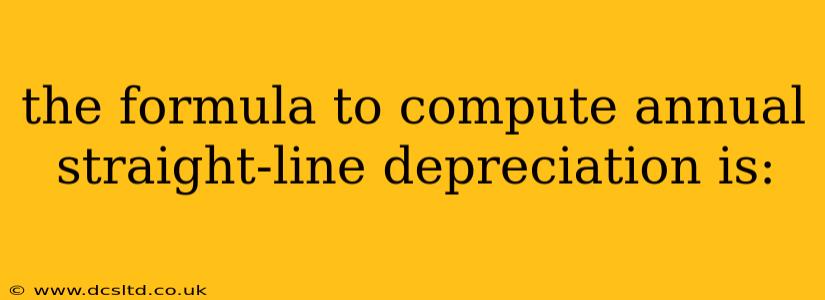The Straight-Line Depreciation Formula: A Comprehensive Guide
The straight-line depreciation method is a simple and widely used technique for allocating the cost of an asset over its useful life. It's favored for its ease of calculation and understanding. This guide will break down the formula, explain its components, and address common questions.
The Formula:
The basic formula for calculating annual straight-line depreciation is:
(Asset Cost - Salvage Value) / Useful Life = Annual Depreciation Expense
Let's dissect each component:
-
Asset Cost: This is the total cost of acquiring the asset. This includes not only the purchase price but also any costs necessary to get the asset ready for use, such as shipping, installation, and setup fees.
-
Salvage Value: This is the estimated value of the asset at the end of its useful life. It's the amount the asset is expected to be worth after it's fully depreciated. If the asset has no salvage value, this figure would be zero.
-
Useful Life: This is the estimated period over which the asset will be used in the business. It's expressed in years. This is an estimate based on factors like industry norms, expected wear and tear, and technological obsolescence.
Example:
Let's say a company purchases a machine for $100,000. The estimated salvage value is $10,000, and its useful life is 10 years. The annual straight-line depreciation would be:
($100,000 - $10,000) / 10 years = $9,000 per year
This means the company will record $9,000 in depreciation expense each year for the next 10 years.
What are the advantages of using the straight-line depreciation method?
The straight-line method is simple to understand and calculate, making it easy to implement and track. Its consistency in depreciation expense each year simplifies financial reporting and forecasting. This simplicity is a major advantage for small businesses and those with limited accounting resources.
What are the disadvantages of using the straight-line depreciation method?
A significant disadvantage is that it doesn't reflect the reality that many assets depreciate more rapidly in their early years than later on. This method assumes a constant rate of depreciation throughout the asset's useful life, which isn't always accurate. For assets that lose value quickly due to technological advancements or wear and tear, the straight-line method might overstate the asset's value in later years.
How is the straight-line depreciation method different from other depreciation methods?
Several other depreciation methods exist, including declining balance and sum-of-the-years' digits. These methods accelerate depreciation in the early years of an asset's life, reflecting a higher rate of value decline. The choice of method depends on the specific circumstances and the nature of the asset. Consult with a tax professional to determine the most appropriate method for your situation.
What factors influence the useful life of an asset?
Determining the useful life of an asset is crucial for accurate depreciation calculation. Several factors influence this estimate:
-
Technological advancements: Assets that become obsolete quickly due to technological changes will have shorter useful lives.
-
Industry norms: Industry averages and guidelines often provide a starting point for estimating useful life.
-
Expected wear and tear: The physical wear and tear an asset experiences will affect its useful life.
-
Company policy: A company's internal policies may also guide the determination of useful life.
Choosing the right useful life is a critical aspect of accurate depreciation, so it's vital to consider all relevant factors.
This comprehensive guide provides a thorough understanding of the straight-line depreciation formula and its implications. Remember to consult with a financial or tax professional for guidance on selecting the most appropriate depreciation method for your specific assets and circumstances.
